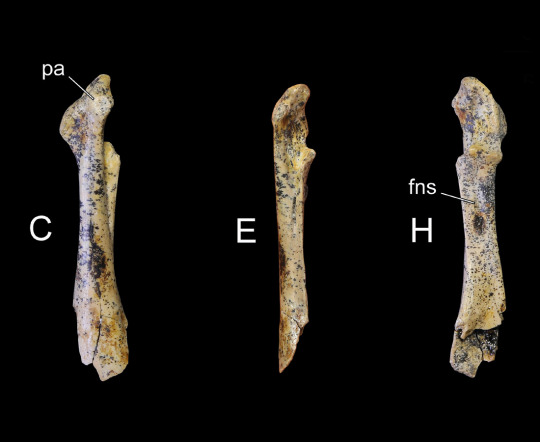#Porzana payevskyi
Text
Porzana payevskyi Zelenkov et al., 2023 (new species)

(Type coracoid [shoulder bone] of Porzana payevskyi, from Zelenkov et al., 2023)
Meaning of name: payevskyi = for Vladimir Payevsky [Russian ornithologist]
Age: Pleistocene (Gelasian)
Where found: Malye Goly, Irkutsk Oblast, Russia
How much is known: A partial right coracoid (shoulder bone)
Notes: Porzana is a genus of small rails including the spotted crake (P. porzana) of Eurasia and Africa, the sora (P. carolina) of North America, and the Australian crake (P. fluminea). P. payevskyi was large for a member of this genus and had a slightly more elongated coracoid than its close living relatives.
Reference: Zelenkov, N., E. Palastrova, N. Martynovich, A. Klementiev, A. Sizov, and N. Volkova. 2023. A tiny duck (Sibirionetta formozovi sp. nov.), a giant grey partridge (Titanoperdix felixi gen. et sp. nov.), a new rail (Porzana payevskyi sp. nov.), and other birds from the Early Pleistocene of Baikalian Siberia. Biological Communications 68: 261–272. doi: 10.21638/spbu03.2023.406
38 notes
·
View notes
Text
Sibirionetta formozovi Zelenkov et al., 2023 (new species)

(Type coracoid [shoulder bone] of Sibirionetta formozovi [scale bar = 10 mm], from Zelenkov et al., 2023)
Meaning of name: formozovi = for Nikolay A. Formozov [Russian zoologist]
Age: Pleistocene (Gelasian)
Where found: Malye Goly, Irkutsk Oblast, Russia
How much is known: A nearly complete right coracoid (shoulder bone).
Notes: Sibirionetta is a genus of ducks including one extant species, the Baikal teal (S. formosa). S. formozovi was much smaller than the Baikal teal, being about the same size as extant pygmy geese (genus Nettapus).
Reference: Zelenkov, N., E. Palastrova, N. Martynovich, A. Klementiev, A. Sizov, and N. Volkova. 2023. A tiny duck (Sibirionetta formozovi sp. nov.), a giant grey partridge (Titanoperdix felixi gen. et sp. nov.), a new rail (Porzana payevskyi sp. nov.), and other birds from the Early Pleistocene of Baikalian Siberia. Biological Communications 68: 261–272. doi: 10.21638/spbu03.2023.406
40 notes
·
View notes
Text
Titanoperdix felixi Zelenkov et al., 2023 (new genus and species)

(Type coracoid of Titanoperdix felixi, from Zelenkov et al., 2023)
Meaning of name: Titanoperdix = titan [in Greek] Perdix [genus of partridges including the gray partridge]; felixi = for Felix Yanovich Dzerzhinsky [Russian zoologist who passed away in 2015]
Age: Pleistocene (Gelasian)
Where found: Malye Goly, Irkutsk Oblast, Russia
How much is known: A fragmentary right coracoid.
Notes: Titanoperdix was a phasianid, a group that includes chickens, partridges, and turkeys. It appears to have been closely related to extant partridges in the genus Perdix, such as the gray partridge (P. perdix). However, it was much larger, being about the size of a male black grouse (Lyrurus tetrix).
Reference: Zelenkov, N., E. Palastrova, N. Martynovich, A. Klementiev, A. Sizov, and N. Volkova. 2023. A tiny duck (Sibirionetta formozovi sp. nov.), a giant grey partridge (Titanoperdix felixi gen. et sp. nov.), a new rail (Porzana payevskyi sp. nov.), and other birds from the Early Pleistocene of Baikalian Siberia. Biological Communications 68: 261–272. doi: 10.21638/spbu03.2023.406
46 notes
·
View notes